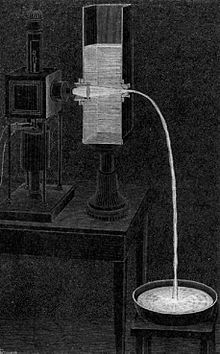Usuario:Mcapdevila/light
- Usuario:Mcapdevila/luz
- Usuario:Mcapdevila/light
- Usuario:Mcapdevila/Protocol
- Usuario:Mcapdevila/Superboard
- Usuario:Mcapdevila/Huion_(Company)

Guiding of light by refraction, the principle that makes fiber optics possible, was first demonstrated by Daniel Colladon and Jacques Babinet in Paris in the early 1840s. John Tyndall included a demonstration of it in his public lectures in London, 12 years later.[1] Tyndall also wrote about the property of total internal reflection in an introductory book about the nature of light in 1870:
When the light passes from air into water, the refracted ray is bent towards the perpendicular... When the ray passes from water to air it is bent from the perpendicular... If the angle which the ray in water encloses with the perpendicular to the surface be greater than 48 degrees, the ray will not quit the water at all: it will be totally reflected at the surface.... The angle which marks the limit where total reflection begins is called the limiting angle of the medium. For water this angle is 48°27', for flint glass it is 38°41', while for diamond it is 23°42'.[2][3]
Unpigmented human hairs have also been shown to act as an optical fiber.[4]
Practical applications, such as close internal illumination during dentistry, appeared early in the twentieth century. Image transmission through tubes was demonstrated independently by the radio experimenter Clarence Hansell and the television pioneer John Logie Baird in the 1920s. The principle was first used for internal medical examinations by Heinrich Lamm in the following decade. Modern optical fibers, where the glass fiber is coated with a transparent cladding to offer a more suitable refractive index, appeared later in the decade.[1] Development then focused on fiber bundles for image transmission. Harold Hopkins and Narinder Singh Kapany at Imperial College in London achieved low-loss light transmission through a 75 cm long bundle which combined several thousand fibers. Their article titled "A flexible fibrescope, using static scanning" was published in the journal Nature in 1954.[5][6] The first fiber optic semi-flexible gastroscope was patented by Basil Hirschowitz, C. Wilbur Peters, and Lawrence E. Curtiss, researchers at the University of Michigan, in 1956. In the process of developing the gastroscope, Curtiss produced the first glass-clad fibers; previous optical fibers had relied on air or impractical oils and waxes as the low-index cladding material.
A variety of other image transmission applications soon followed.
In 1880 Alexander Graham Bell and Sumner Tainter invented the Photophone at the Volta Laboratory in Washington, D.C., to transmit voice signals over an optical beam.[7] It was an advanced form of telecommunications, but subject to atmospheric interferences and impractical until the secure transport of light that would be offered by fiber-optical systems. In the late 19th and early 20th centuries, light was guided through bent glass rods to illuminate body cavities.[8] Jun-ichi Nishizawa, a Japanese scientist at Tohoku University, also proposed the use of optical fibers for communications in 1963, as stated in his book published in 2004 in India.[9]
- ↑ a b Bates, Regis J (2001). Optical Switching and Networking Handbook. New York: McGraw-Hill. p. 10. ISBN 0-07-137356-X.
- ↑ Tyndall, John (1870). «Total Reflexion». Notes about Light.
- ↑ Tyndall, John (1873). «Six Lectures on Light».
- ↑ Wells, J. (1989). «Hair light guide». Nature 338 (6210): 23. Bibcode:1989Natur.338...23W. PMID 2918918. doi:10.1038/338023b0.
- ↑ Hopkins, H. H. and Kapany, N. S. (1954). «A flexible fibrescope, using static scanning». Nature 173 (4392): 39. Bibcode:1954Natur.173...39H. doi:10.1038/173039b0.
- ↑ Two Revolutionary Optical Technologies. Scientific Background on the Nobel Prize in Physics 2009. Nobelprize.org. 6 October 2009
- ↑ Jones, Newell. First 'Radio' Built by San Diego Resident Partner of Inventor of Telephone: Keeps Notebook of Experiences With Bell, San Diego Evening Tribune, July 31, 1937.
- ↑ The Birth of Fiber Optics. inventors.about.com
- ↑ Nishizawa, Jun-ichi and Suto, Ken (2004). «Terahertz wave generation and light amplification using Raman effect». En Bhat, K. N. and DasGupta, Amitava, ed. Physics of semiconductor devices. New Delhi, India: Narosa Publishing House. p. 27. ISBN 81-7319-567-6.
